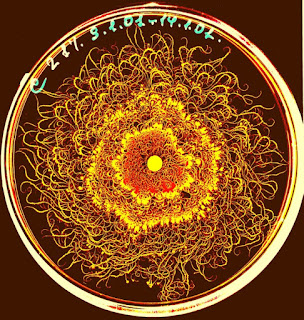 |
| Source. |
I should begin by pointing out that I am not a perfumer. Actually
I should begin by pointing out that there is such a thing as bacteria art, also
called agar art, as seen above. Let me start again – I am not a perfumer; I am
a writer interested in the language of smells. Obviously, perfume is a big part
of that. But when I learn that bacteria are used to make perfumes it comes as a
surprise to me, and I feel like I missed something. (And when I had been an art
teacher for over ten years and I realize there’s such a thing as bacteria art,
I also feel like I missed something, except for the fact that I only discovered
radiation
art a month ago.)
Apparently, fragrance experts are also a bit surprised. Engineering
microorganisms to make specific odorous chemicals are a new addition to the
typical methods of expression, steam distillation, and solvent extraction.
It all started
with a project done by a scientist named Reshma Shetty and a team at MIT. I'm
almost as excited about the name as I am the project - it was called Eau
De Coli, after the dignified Escherichia coli. And it can be translated as "water of
the colon."
E. coli isn't just for making you sick, or for making Chipotle
go Chapter 11, it's also for scientists trying to research bacteria. E. coli is
the model organism for scientific study, probably because of the compendium of
literature already amassed due to its dangerous nature, and maybe just because
it's easy to work with.
Regardless, dissertation-defending Shetty and her group
engineered this archetypal organism to be a smell-generating machine. Usually
E. coli smells like crap, literally, so they first had to find a mutant strain
that had no genetic propensity for producing that smell. (This smell comes from
the molecule Indole, by the way, and is related to Skatole, which doesn't sound
like "skat" by accident.)
The next part was right out of a science fiction novel.
They found enzymes that would produce the smells of wintergreen (methyl
salicylate) and banana (isoamyl acetate), and they programmed the bacteria to
produce those chemicals. So now, instead of smelling like crap, they smell like
mint and bananas!
This is called odor engineering - a kind of genetic
engineering that is used to make odor chemicals from bacteria. The researcher
here, Dr. Shetty, suggests using this technique to probe bacteria at an
industrial scale. Imagine you engineer the bacteria in your business to produce
different smells at different stages in its metabolism. You could then tell
what the bacteria are doing just by sniffing them.
Then there's others who are simply coaxing bacteria to
produce otherwise difficult fragrance chemicals. Folks at the Joint BioEnergy Institute at Lawrence Berkeley Labs were originally trying
to get bacteria to make biofuels. But after they accidentally
discovered a way to make methyl ketones, the fragrance industry perked up.
Combining genetic-metabolic engineering and fragrance
production may be a breakthrough for the industry. Now if only we could find a
way to engineer ourselves not to secrete isovaleric acid from the soles of our
feet!
Notes:
Dr. Shetty's
genetic odor engineering Eau de Coli project:
Shetty, R. P. Applying Engineering Principles to the
Design and Construction of Transcriptional Devices. Department of Biological
Engineering, MIT (2008).
Lawrence Berkeley
Labs bioengineering efforts:
From Petri Dish to Perfume, Berkeley Science Review
Post Script:
While I research odor engineering, I find some things
that fall well outside the realm of fragrance.
Odor Science &
Engineering, Inc. will research environments that stink and develop
products that don't. Instead of using bacteria, they rely on good ol' nose
megaphones (see below, a screenshot from their site.)
 |
| Source. |
Here's some of the odor-absent products they have helped
to develop:
High performance athletic wear
Socks
Hunting clothing
Cat litter
Trash bags
Room deodorizers
Shoe/Sneaker deodorizers
Post Post Script
Just when you let your guard down, the internet provides
you with Bacteria Art, aka Agar Art. Yup.
 |
| Bacteria Art |
 |
| Bacteria Art |
 |
| Check out this entire gallery of bacteria art. |






